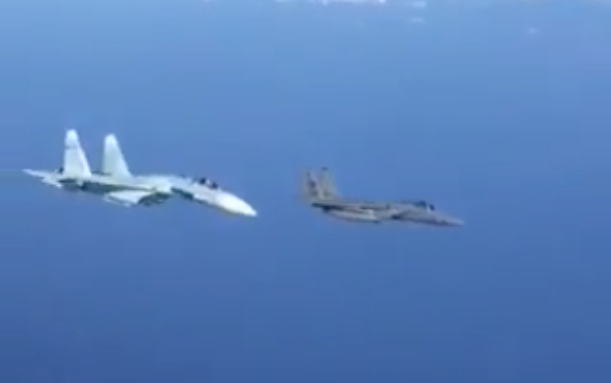The footage is doing the rounds.
A clip that shows a Russian Air Force Su-27 Flanker aggressively banking into a U.S. Air Force F-15C Eagle has appeared online. It’s not clear where and when the footage was taken but, provided it is genuine (it seems so), it was probably filmed in the Baltic region, when the U.S. Air Force F-15C) were supporting NATO BAP (Baltic Air Policing) mission.
Last time U.S. Air Force supported BAP was during the 45th BAP rotation between August and December 2017.
Here’s the video (click this link in case it does not play in the embedded tweet below)
#BREAKING: A #Russian Air Force pilot has released this video showing how a #RuAF Su-27P (from 72nd Guards AvB) dangerously banked in front of a #USAF‘s F-15C of 493rd Fighter Squadron while it was patrolling over #Baltic Sea as a part of #NATO Baltic Air-policing mission. pic.twitter.com/zVU5dN4rpe
— Babak Taghvaee (@BabakTaghvaee) January 31, 2019
Su-27 Flankers flying in international airspace from mainland Russia to Kaliningrad and back, often escorting other aircraft (including Tu-22, Tu-134 and An-72 jets) are frequently intercepted by NATO fighters in QRA (Quick Reaction Alert). The Russian aircraft operate with no FPL, onboard transponders off, and usually do not maintain radio contact with the local air traffic control agencies and for this reason they are identified and escorted by NATO aircraft based in Lithuania and Estonia.

Back in June 2017, a similar clip, filmed from the Tu-154 carrying Russian Defense Minister Sergei Shoigu en route to the Russian exclave of Kaliningrad emerged. The video showed an escorting Russian Su-27 inserting itself between a NATO F-16 and rocking its wings to show its missiles. At that time Polish Air Force F-16s were supporting BAP from Lithuania.
Russian Su-27 intercepting spyplanes around the world have often performed what American officials have defined “aggressive maneuvers” against U.S. aircraft. As happened on Jan. 29, 2018, when a U.S. EP-3 Aries aircraft flying in international airspace was intercepted by a Russian Su-27 over the Black Sea; on Apr. 29, 2016, when a Russian Su-27 Flanker barrel rolled over the top of a U.S. Air Force RC-135 aircraft operating in the Baltic Sea; on Apr. 14, 2016, when another Su-27 carried out the same dangerous maneuver on another US Rivet Joint over the Baltic; on Jan. 25, 2016 when a Russian Su-27 Flanker made an aggressive turn that disturbed the controllability of the RC-135; or on Apr. 7, 2015, when a Flanker flew within 20 feet of an RC-135U over the Baltic Sea.
Close encounters between U.S. and Soviet/Russian aircraft have always occurred. And some “stunts” have also been carrried out by U.S. pilots.
In at least some of those cases though, the maneuvers were performed at request of the Russians: in a story we have published about a blurry shot of a U.S. Air Force F-4 Phantom flying inverted during an intercept mission on a Russian Tu-95 Bear, Robert M. Sihler, a Phantom pilot with 57th FIS at Keflavik NAS, told us:
“At that time, we probably averaged two intercepts of “Bears” per week. They were the only aircraft we saw while I was there. Generally, the intercepts occurred on Fridays and Sundays, at the “Bears” flew from Murmansk to Cuba on training and, we guessed, “fun” missions. Generally, we did these barrel rolls at the request of the Soviet crewmembers. They gave us hand signals to let us know they wanted us to do it. They photographed us as well. The Cold War was winding down and the attitudes on both sides had improved.”
When asked whether the barrel roll was difficult or unsafe maneuver, Bob has no doubts: “Not really! The Soviets, at the time, gave us hand signals asking us to “perform” for them. The rolls were not dangerous at all.”
Still, one thing is performing a barrel roll on request; another thing is to turn into an armed interceptor as happened in case of the close encounter between the Su-27 and the F-15.









